Common diseases in organic hoophouse greens
In much of northern Michigan, growers are seeing a cold and wet spring. While hoophouses help mitigate some of these problems, foliar and root diseases in high-value, organic hoophouse crops can prove to be challenging to growers across the state.
Lettuce, spinach and leafy brassica greens are some of the leading spring crops for Michigan hoophouse growers. While these crops can be profitable, they can be excellent hosts for fungal and bacterial pathogens, especially in the high humidity environment of the hoophouse. Organic growers have limited tools in their toolbox to address outbreaks, but understanding proper management and cultural practices can reduce the likelihood of infection. Below are some common diseases that Michigan growers may face.
Downy Mildew
This pathogen can be very problematic for greens growers in low light, low temperature and high moisture environments. Even more challenging, downy mildew (DM) has a different identified “races,” each of which behaves differently and can infect different varieties. For example, there are currently 16 identified DM races that infect spinach and new races are emerging that allow the pathogen to infect genetically resistant varieties.
On spinach, DM appears as a fuzzy, purple-gray growth on the underside of leaves and light yellow spotting on the opposing side. Advanced infections will cause infected foliage to turn tan and dry out, causing crop death and making it unmarketable.
On lettuce, the top side of leaves will have yellow or light green sections bound by plant veins. The underside of leaves will have white, somewhat fluffy growth that appears somewhat similar to powdery mildew.
DM resistant varieties are available, but resistance is restricted to specific races. Selecting varieties that have broad resistance is a first line of defense. Other methods of control include limiting leaf wetness, utilizing proper crop rotations, removing plant residues after harvest, and removing infected plants as soon as the pathogen is identified. Regularly removing row covers to reduce relative humidity and timing irrigation to allow for leaf drying help prevent the spread of this pathogen.
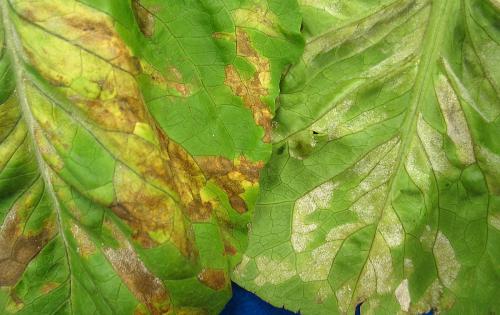 |
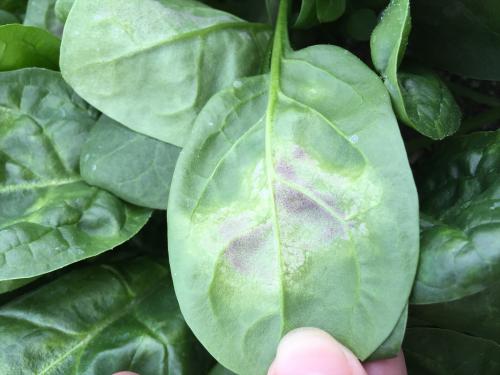 |
|
Downy Mildew on Lettuce. Photo by Margaret McGrath, Cornell University |
Downy Mildew on Spinach. Photo by Margaret McGrath, Cornell University |
Cladosporium leaf spot
A concern for spinach, this pathogen is characterized by small (less than 1cm), round spots with tan-green fungal growth. Like many fungal pathogens, Cladosporium favors cool, wet conditions, so growers may see improvements with proper water management, circulation, and ventilation. Cladosporium also can be seed-borne, so growers may want to consider hot water or steam treatment of seeds prior to planting.
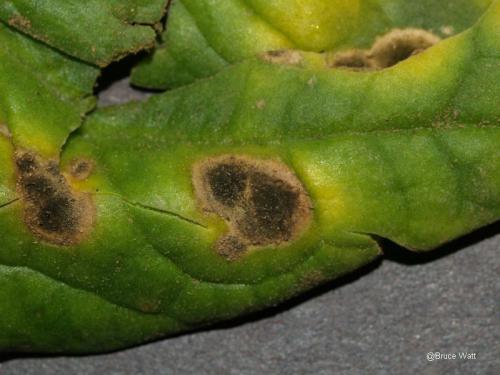
Cladosporium spp. on Spinach. Photo by Bruce Watt, University of Maine Cooperative Extension
Damping off/Root Rot
Several pathogens can cause damping off in seedlings, including Fusarium, Pythium, and Rhizoctonia. Symptoms include poor germination, lack of vigor at germination, tissue death/stunting at the soil line, and seedling death. Damping off is often an issue in poorly drained soils, as excessively wet conditions are favorable for these pathogens. Managing soils properly and closely monitoring irrigation are important steps in reducing disease emergence. Some possibility exists for pathogen transfer on the seed, so growers may benefit from pre-planting seed treatments.
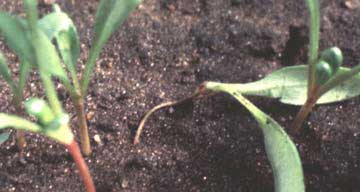
Damping off of spinach. Photo by J. Brantner, Washington State University
Powdery Mildew
Powdery mildew is one of the more easily recognizable foliar diseases due to its characteristic powdery white growth on both top and bottom leaf surfaces. Oftentimes spotted in the fall on cucurbits, this pathogen can infect brassicas and lettuce in the hoophouse.
Many growers confuse powdery mildew and downy mildew. It is critical to understand the differences between these pathogens, as control methods and treatments are different. Powdery mildew develops best under dry conditions, so reducing leaf wetness will not have the same effect as it does for DM control. Instead, organic fungicides can be used, which often consist of biologicals that are designed to outcompete the pathogen. Growers must ensure that any fungicide is listed for the specific pathogen being controlled and instructions are followed appropriately.
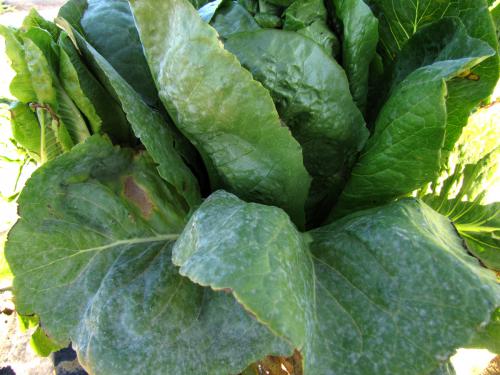
Powdery Mildew on Lettuce. Photo by Margaret McGrath, Cornell University
Collin Thompson is the Farm Manager of The North Farm at the Michigan State University Upper Peninsula Research and Extension Center in Chatham, Michigan and a Small Farm Educator with Michigan State University. Extension.



 Print
Print Email
Email



